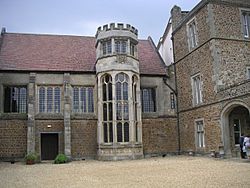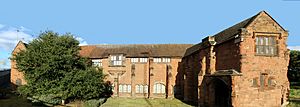Robert Waldegrave facts for kids
Quick facts for kids
Robert Waldegrave
|
|
|---|---|

Fawsley Hall, home of Sir Richard Knightley, where Robert Waldegrave printed Martin Marprelate's Epitome on a secret press
|
|
| Born | c.1554 |
| Died | October 1603 |
| Spouse(s) | Mary (surname unknown) |
| Children | seven children, including a son, Robert |
| Parent(s) | Richard Waldegrave, mother's name unknown |
Robert Waldegrave (around 1554 – October 1603) was an important printer and publisher. He lived in England and Scotland during the 1500s. From 1578 to 1588, he printed many religious books in London. Later, from 1590 to 1603, he printed over 100 books in Scotland.
Waldegrave is famous for two main things. First, he printed the first four of the Marprelate tracts using a secret printing press. Second, he printed books for King James I of Scotland. In 1603, he returned to England when King James became King of England. Sadly, he died that same year.
Contents
Robert Waldegrave's Family Life
We don't know much about Robert Waldegrave's parents. His father was Richard Waldegrave, a farmer from a place called Blockley. Richard died before 1568.
Robert Waldegrave likely got married around 1580. His wife's name was Mary. They had six children before Robert moved to Scotland. Their seventh child, named Robert like his father, was born in Edinburgh in 1596.
Starting His Printing Career
On June 24, 1568, Robert Waldegrave began learning to be a printer. He worked for eight years with William Griffith, a London stationer. A stationer was someone who sold books and writing materials.
After his training, Waldegrave became a licensed publisher in 1578. His first licensed book was The Castle for the Soule. This was one of many religious books he would print.
Waldegrave's main printing shop was "Without Temple Bar in the Strand" in London. He also had other shops sometimes. By 1583, he owned two printing presses.
He became known for printing books by religious leaders who disagreed with the official church. These included people like Dudley Fenner and John Field. He also printed works by famous European religious reformers.
Because of his printing, Waldegrave was put in prison twice. He spent 20 weeks in the White Lion prison in 1586–87. In 1588, a special court called the Star Chamber limited his printing. That April, officers took his press and most of his type. They also burned copies of a book he printed. Waldegrave managed to escape with some type hidden under his coat.
The Secret Marprelate Tracts

Waldegrave hid his printing type at the home of Mistress Crane. She was a supporter of religious reform. In 1588, she let Waldegrave set up a secret printing press at her country home. This home was in East Molesey, Surrey.
The first book printed there was Demonstration of Discipline. Then, in late 1588 and early 1589, Waldegrave printed something even more controversial. He printed the first four books written by a secret writer called Martin Marprelate. These books criticized the church leaders.
The first Marprelate book, Martin's Epistle, was printed in October 1588. It became very popular. Church authorities tried to find Martin and his press. In November, the press moved to Sir Richard Knightley's house in Fawsley. There, Martin's second book, The Epitome, was printed.
The secret press moved again to Whitefriars, Coventry. This was the home of John Hales. Here, Certaine Minerall and Metaphysicall Schoolpoints and Hay Any Worke for Cooper were printed. Waldegrave then refused to print any more of Martin's books. This was because some Puritan ministers did not approve of Martin's actions.
Waldegrave had a powerful supporter in James VI of Scotland. King James even asked Sir Robert Melville to help Waldegrave with Queen Elizabeth.
Printing in Scotland
We don't know exactly where Waldegrave went right after leaving the secret press. But by early 1590, he was in Edinburgh, Scotland. He received a license to print there. On October 9, King James VI appointed him as the King's Printer.
From 1590 until his death in 1603, Waldegrave printed over 100 books. This made him the most active printer in Scotland during the 1500s. He mainly printed religious books. But he also printed other works, like The Sea-Law of Scotland and a copied version of Sir Philip Sidney's The Arcadia. He also printed three books by King James himself: Poetical Exercises, Daemonologie, and Basilikon Doron.
In 1594, the English ambassador asked Waldegrave about printing a book called Principis Scoti-Britannorum Natalia. This book talked about who would become the next King of England. Waldegrave said he didn't know enough Latin to understand it. King James also said he hadn't read it.
In 1597, Waldegrave was found guilty of "treasonably printing" a Scottish law. However, this conviction was later canceled.
When King James became King of England in 1603, Waldegrave returned to England. He left his printing business in Edinburgh to his wife. He got a new printing license in London in June 1603. But he died later that year during a plague outbreak. He was buried on October 22.
Images for kids
-
Fawsley Hall, home of Sir Richard Knightley, where Robert Waldegrave printed Martin Marprelate's Epitome on a secret press
-
The Whitefriars, Coventry, home of John Hales, where Waldegrave printed the Schoolpoints and Hay Any Work For Cooper on the secret press


